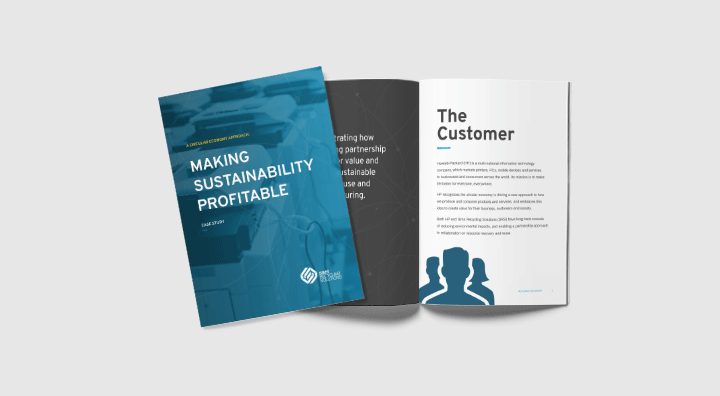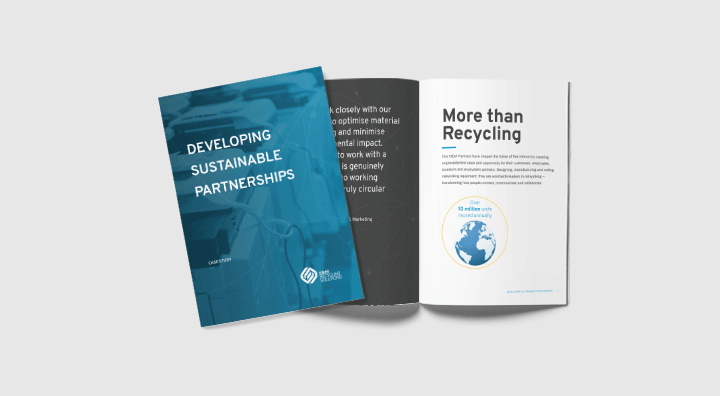The process of changing to a new vendor can be intimidating, however appropriately resourcing vendor-to-vendor transitions minimizes risk and adds value.
You completed your selection process, RFPs are reviewed, and the best scoring vendor has been selected. The stakeholders in your organization are satisfied and all the hoops jumped through. The contract is signed, sealed and delivered. For many, onboarding new vendors and transitioning from one vendor to another sounds complicated and time-consuming. However, it does not have to be as bad as you would imagine, especially when choosing a vendor like Sims Lifecycle Services, who can offer onboarding support.
Unlike buying products, engaging service providers requires a partnership that lasts long after the purchase decision is made. The relationship between B2B vendors and clients begins long before the service provision and it is crucial that the supplying company safeguards this relationship throughout the transition process.
“80 percent of vendors rate ease and speed of onboarding as highly important to their success” (McKinsey)
Changing from one vendor to another can be complex, particularly when that vendor is providing services to multiple countries, jurisdictions or legal entities, but it does not need to be difficult. Taking time to plan, resource and safeguard your transition process can avoid compliance, billing and security challenges later on.
Each service has its own complexities and minutiae, and IT asset disposition (ITAD) services are no exception. Moving electronic equipment globally can get complicated due to varying legislation covering, UEEE (used electronic and electrical equipment), WEEE (waste electronic and electrical equipment), movement of waste, customs, tax and waste management. Regulations can vary between countries and even states, counties or regions.
International companies and equipment manufacturers are seeking globally consistent ITAD service provision to match their own footprint and meet their environmental and compliance goals. This, in turn, makes the need for a low-hassle transition more prevalent.
Why prioritize the onboarding process?
How often have you gone through a tender process and selected the best partner on paper, only to hear complaints from the business for the next 6-12 months? Unfortunately, this is how most procurement professionals view the process.
A recent study by Gartner revealed that over 75 percent of IT projects fail, with failed vendor transitions given as a major reason why.
Change is hard. It can be tedious, cumbersome and sometimes fraught with difficulties. Procurement is not easy. A lot of time goes into the vendor selection process. A properly prioritized transition can make or break a new project, and is crucial to ensure the front-end procurement work is not wasted, or worse, blamed for project failure.
Today’s technology organizations are using more vendors than ever, as services are more embedded into our supply chains and our organizational eco systems. Putting vendor transitions at the top of your agenda ensures service continuity.
Organizations with large international footprints have stakeholders across the globe that need to be engaged to ensure effective service provision.

Case Study - Making Recycling Sustainable and Profitable
Our work with an electronic OEM to develop a true closed loop solution for printer plastic is delivering tangible financial and sustainability results.
Smooth transitions make the magic happen
Considering onboarding as a stand-alone service can be worthwhile and deliver long-term value. Working with a Transition Manager, and setting aside appropriate resourcing and funding on the front end will ensure agreed upon goals and deliverables. Actions will be deliberate, understood and planned. Be sure to allocate time to transition your service and allow your designated Transition Manager to understand your business. Experience has shown that an early, comprehensive understanding of your organization is an enabler for long-term productive and innovative partnerships.
A transition manager looks backward, forward and all around.
- All Around
- Backward
- Forward
Disposal and reuse of your office, cloud infrastructure and mobile equipment can play an important role in achieving the security, sustainability, compliance and value recovery goals you put in place. Your ITAD partner for data center and office IT equipment can become part of your ecosystem and should help you work toward those goals.

Developing Sustainable Partnerships
SLS works closely with our clients to optimize material recycling and minimize environmental impact. It’s great to work with clients who are genuinely dedicated to working towards a truly circular economy.
“What’s in it for me?”
What do you want from the transition process? You want to,
- Be paid your revenue returns for your reused equipment,
- Receive invoices for your equipment, and
- Have the same, legally compliant service deployed across all your legal entities globally.
The requirements are simple, the execution can be too – when it is planned for, resourced and given appropriate priority.
Steps for Success
Successful transition processes are standardized but the tasks are specific to your requirements. You should ask your vendor if they have,
- A defined process
- System tools to track progress
- A list of questions to ask you
- Evidence of experience and knowledge specific to ITAD and recycling services
The temptation to skip any of these steps during this transition can expose your company to unnecessary risks. Use this checklist for a successful transition.
Did you know? Sims Lifecycle Services allocates a dedicated Transition Manager to all new international ITAD clients.
Step 1: Information Gathering
Understanding your business is essential. The first thing your vendor should do during your transition is gather information about your business, your business processes and your stakeholders. Most organizations will have their own vendor onboarding requirements –information that you need to meet stakeholder needs in your organization. The initial information gathering process should capture all your data needs.
Information gathering should consider the geographical coverage of your contract and your business structure. Information needs are not the same in every country or legal entity. Language, currency, cultural, tax and legal aspects should all be considered.
Step 2: Data Collection
This will involve the process of collecting the documentation and data needed to set up a company as an approved vendor and enable your organization to efficiently conduct business, purchase goods and services, and make payments to that company.
Step 3: Planning
What do we do, and when? The planning process sets out a clear order of tasks and priorities shared between client and vendor. Your initial planning meetings should provide answers to the following questions:
- Where do you want your first collection to happen?
- What are your service priorities?
- Do you have any current service gaps, backlogs or urgent projects?
- What problems do you need help solving?
Always remember to consider risk in this decision making process. Often the focus is on high volume sites in large countries. Frequently areas that need the most attention are lower volume sites in harder to reach geographies. Your unique requirements, combined with the right expertise will form the basis of the onboarding plan for your new global ITAD service.
Step 4: Team Responsibilities and Communication
It is crucial to a smooth transition to have clearly established goals and responsibilities. Sims Lifecycle Services (SLS) allocates a Transition Manager and a Contract Manager to support the onboarding of your new IT asset disposition service. That Contract Manager will then stay with you for the life of your project. Building strong team relationships from the outset will allow your vendor to engage directly with your organization.
Change management is your opportunity to tell your business stakeholders about the change and make it a positive experience. At this point, your vendor should be able to communicate the goals of your new service project effectively to the key stakeholders in your business.
SLS works with clients to engage with stakeholders formally and informally in accordance with your connection strategies.
Step 5: Contractual Requirements
When you are transitioning to a new vendor covering multiple countries and jurisdictions, there may be cases where specific tax, waste movement, financial or other legislation requires deviations to standard global services. These should be identified and managed as part of the onboarding process.
Step 6: System Set Ups
To initiate the provision of the ITAD and recycling service, all relevant users will need to be set up in each other’s systems. Your vendor should work with you to understand both of your system requirements so you are setup on both ends. This includes setting up requirements for your specific ITAD services such as field services, onsite shredding, asset recovery, and data destruction.
Identify the material types you will be returning such as cloud infrastructure, workplace equipment, consumer electronics or mobile devices, and enable the systems to receive this equipment.
Step 7: Customized Training Plan
Tailoring your internal training to meet your business needs supports effective onboarding. Have your vendor identify the services and system features relevant to your business and get your stakeholders up and running quickly. Focus on what matters most to you, and work with a vendor who will demonstrate their service value from the outset.
SLS training delivered to users includes,
- Service options
- Expectations and service level agreements
- Instructions for requesting equipment collections
- Portal requests and reporting
SLS’ Top Tips for Smooth Transition
- Allocate a transition process owner within your organization
- Allocate time and resources to facilitate smooth transition.
- Communicate, educate and motivate your key stakeholders and expect your new vendor to be part of this process
- Track progress make a plan and track progress against it.
- Focus on the right things, agree on shared priorities with your vendor and plan accordingly
- Ongoing transition should not be forgotten. When your contract expands to a new country or a new business unit, expect your vendor to transition with you in any new regions to ensure the same consistency of service and positive customer experience.
In Conclusion
Effective onboarding allows you a smooth transition to your new service provider, and enables you to deploy your global program with confidence. A planned, resourced and well-communicated transition plan mitigates risk, improves efficiency and gives you and all your stakeholders a level of comfort.
A poorly performing vendor can be costly in terms of reputation, resource and motivation. Time invested in your onboarding transition is time well spent. Building strong relationships and acquiring a thorough understanding of your business allows you to effectively plan. It is important, even at this early stage, to prepare for scaling up the business and continuing relationship growth.
